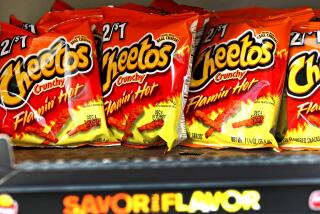See Sally count. See Sally eat.
- Share via
ANYONE WONDERING why American kids are so fat should take a look at “The Oreo Cookie Counting Book.” “Ten little Oreos, all in a line,” its first page says, next to an illustration of a child’s hand eagerly extended toward a row of cookies. “Dunk one in a glass of milk, and now there are ... nine.”
Unfortunately, the book -- published by an imprint of Simon & Schuster and recommended for children ages 4 to 8 -- fails to mention what would happen if you actually followed its instructions. “Children will love to count down as 10 little Oreos are dunked, nibbled and stacked one by one ... ,” says its back cover, “until there are none!” Ten Oreos have more than 20 grams of fat and 500 calories -- almost a third of the energy the average 4- to 8-year-old needs per day. Sure, counting is important, but isn’t there a low-cal version?
Not really. When it comes to product placement masquerading as education, junk foods dominate the market.
“What better way to introduce simple addition concepts than with delicious Hershey’s Kisses?” reads the description of “Hershey’s Kisses Addition Book” at Amazon.com. (It’s not to be confused with the “Hershey’s Kisses Subtraction Book,” the “Hershey’s Kisses Multiplication and Division Book” or “Hershey’s Fractions.”) Your kid hates Hershey’s? Try the “M&Ms; Addition Book,” “Skittles Riddles Math” or the “Twizzlers Percentages Book,” in which space aliens descend on a classroom and, in an unexpected plot twist, demand Twizzlers in exchange for lesson plans. It’s a strategy best summarized by “Reese’s Pieces: Count By Fives”: “Don’t just play with your food,” says the online blurb, “Learn with it!”
The problem, of course, is that encouraging children to learn with junk food also encourages them to eat it, a point surely not lost on whoever came up with the idea behind “Hershey’s Milk Chocolate Weights and Measures” and its “cast of miniature clowns struggling under the weight of life-sized Hershey’s Kisses.” Perhaps a more appropriate plot line would feature the American healthcare system struggling under the weight of Hershey’s Kisses-shaped children.
And anyone horrified by cookie-counting books should take a closer look at the labels on the food in his shopping cart -- junk-food lesson plans aren’t confined to the library. Rather, food companies are trying to distract parents’ attention from poor nutritional content by printing “educational” materials on junk-food packaging.
Take, for example, Keebler Grahams’ Bug Bites -- miniature, insect-shaped cookies in boxes illustrated with a game that explains the anatomy of a dragonfly. Or Sorrento’s Stringsters string cheese with trivia questions on the wrapper, complete with a professorial mascot -- his thin, cheesy body dressed in a lab coat and glasses, with books under both arms.
Still, string cheese is arguably healthier than Yoplait’s sugar-filled Yumsters brand, whose label boasts that “pediatricians recommend yogurt to teach self-spoon-feeding to toddlers.” (Yes, that’s right: yogurt promotes hand-eye coordination). And thanks to General Mills’ “Box Tops for Education” program, purchasing a box of Pillsbury Toaster Strudel Pastries could earn $10,000 for your school -- just check the inside of the label once you squeeze out the strudel topping.
IT’S OBVIOUS WHY food companies pursue every angle to reach children (and their parents) -- the estimated purchasing power of 2- to 14-year-olds is $500 billion, and dietary habits established in childhood are likely to persist into adulthood.
Unfortunately, most of the habits the food companies are encouraging aren’t healthy ones. A December 2005 report by the Institute of Medicine of the National Academies points out that obesity in children has more than tripled in the last four decades, and that “the prevalence of obesity in children and youth has occurred in parallel with significant changes in the U.S. media and marketing environments.” The report’s summary is not optimistic: “The prevailing pattern of food and beverage marketing to children in America represents, at best, a missed opportunity, and, at worst, a direct threat to the health of the next generation.”
If the food companies aren’t going to resist “educational” marketing techniques, consumers should. For until we refuse to buy junk food that masquerades as lesson plans -- a political statement that is very easy, personally, to make -- our kids’ health problems will be too numerous to be counted with one package of Oreos.
More to Read
Sign up for our Book Club newsletter
Get the latest news, events and more from the Los Angeles Times Book Club, and help us get L.A. reading and talking.
You may occasionally receive promotional content from the Los Angeles Times.






